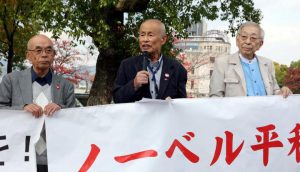Nihon Hidankyo’s path to Nobel Peace Prize, Part 7: Efforts toward elimination of nuclear weapons driving force behind adoption of TPNW
Dec. 7, 2024
Survivors undefeated by severe international situation
by Fumiyasu Miyano and Michio Shimotaka, Staff Writers
On November 22, amidst a cold wind, Toshiyuki Mimaki, 82, chair of the Japan Confederation of A- and H-Bomb Sufferers Organizations (Nihon Hidankyo) who also serves as chair of the Hiroshima Prefectural Confederation of A-bomb Sufferers Organizations (Hiroshima Hidankyo), and Kunihiko Sakuma, 80, chair of the other Hiroshima Hidankyo organization, stood in Peace Memorial Park, located in Hiroshima’s Naka Ward. They raised a banner communicating the decision to award Nihon Hidankyo with the Nobel Peace Prize as well as the sentiment that “Japan’s government must join the Treaty on the Prohibition of Nuclear Weapons (TPNW),” requesting support from citizens and tourists in the park for their signature drive.
The groups have worked on the initiative every two months since the TPNW went into effect on January 22, 2021. The Japanese government has neither signed the treaty, due to its reliance on “the nuclear umbrella” provided by the United States, nor participated in the two meetings of States Parties to the TPNW held to date. Satoshi Tanaka, 80, director of the Hiroshima Alliance of A-bomb Survivor Organizations (Hidanren), was emphatic. “Japan should attend the TPNW States Parties meetings as an observer at the very least. Otherwise, we’ll be embarrassed when we travel to the award ceremony.”
Signatures collected from 13. 7 million people
Nihon Hidankyo has not only demanded that the national government provide compensation for damages caused by the atomic bombings but also urged, “Do not let nuclear war happen: Ban nuclear weapons!” In the 60th year after its founding, the organization put forth the Hibakusha Appeal, an international signature drive urging governments around the world to formulate a treaty to ban and eliminate nuclear weapons. In March 2016, with collaboration from other civic groups, the organization initiated a signature drive. Signatures collected from 13.7 million people throughout the world by the end of December 2020 were submitted to the United Nations.
When like-minded nations gathered to discuss the inhumane nature of nuclear weapons at international conferences held in 2013 and 2014, Nihon Hidankyo sent its directors to push for establishment of a treaty. At a meeting held in Vienna, Austria in December 2014, Terumi Tanaka, 92, current co-chair of the Nihon Hidankyo organization, called on the meeting participants to imagine what had happened under the mushroom cloud that arose after the atomic bombing, stressing that “the only way to guarantee that the weapons will not be used a second time is if nuclear weapons don’t exist.”
Nihon Hidankyo’s contributions helped result in the TPNW being adopted by the United Nations in July 2017, along with a treaty preface containing such descriptions as, “Mindful of the unacceptable suffering of and harm caused to the victims of the use of nuclear weapons (hibakusha)” and, “Recognizing the efforts undertaken by the hibakusha.” Elayne White, who served as chair of the negotiations to establish the TPNW, expressed her appreciation for the A-bomb survivors at a press conference held after the treaty’s adoption, explaining that the driving force behind the meeting’s successful result was the survivors, who had shared their experiences in the bombings with others over so many years.
Nevertheless, the selection of Nihon Hidankyo as the recipient of the Nobel Peace Prize underlies the tense international situation surrounding nuclear weapons. Nuclear-armed nations have consistently opposed the TPNW. Last month, Russia, the nation that has invaded Ukraine, lowered the bar for use of its nuclear weapons, by defining an invasion from a non-nuclear nation supported by a nuclear power as part of an added scope justifying its use of its nuclear deterrence, given that it would consider the action to be a joint attack on Russia.
Younger generations also affected
As the risk of nuclear weapons use rises, Nihon Hidankyo’s work continues to serve as a guidepost for future generations. Students at Showa Women’s University and other schools in Tokyo analyzed materials related to the activities of Nihon Hidankyo and held a touring exhibition featuring “the basic demands of those suffering from the atomic bombings” in the Tokyo metropolitan area. Fumie Igarashi, 19, a second-year student at the university, focused on Nihon Hidankyo’s idea of seeking national compensation for A-bombing damages as a promise to not cause nuclear devastation. “Through our exhibition, we want to share our sense of urgency about the fact that the Japanese government has not agreed to national compensation and has still not changed its position.”
On November 30, after Nihon Hidankyo was awarded the Nobel Peace Prize, Jiro Hamasumi, 78, the organization’s deputy secretary-general, and Yuta Takahashi, 24, an activist from Fukuyama City who is engaged in work toward the abolition of nuclear weapons, engaged in dialogue in Tokyo. Mr. Hamasumi, a relatively young member of Nihon Hidankyo who experienced the atomic bombing in his mother’s womb in Hiroshima, described how the TPNW was one of the goals achieved by his organization as a result of its activities, but he also expressed his concerns about the future. “The power of the hibakusha will decline over time. I am worried about what will happen in a decade or two,” he said.
Regarding such concerns, Mr. Takahashi thinks we have entered “a new phase” in which a variety of organizations sharing the common spirit of A-bomb survivors’ groups will be connected in a network. “I want the issue of the elimination of nuclear weapons to be a challenge for everyone, rather than merely a special movement of the hibakusha.” As people alive at the present time, we have a responsibility to save humanity from this crisis.
(Originally published on December 7, 2024)








